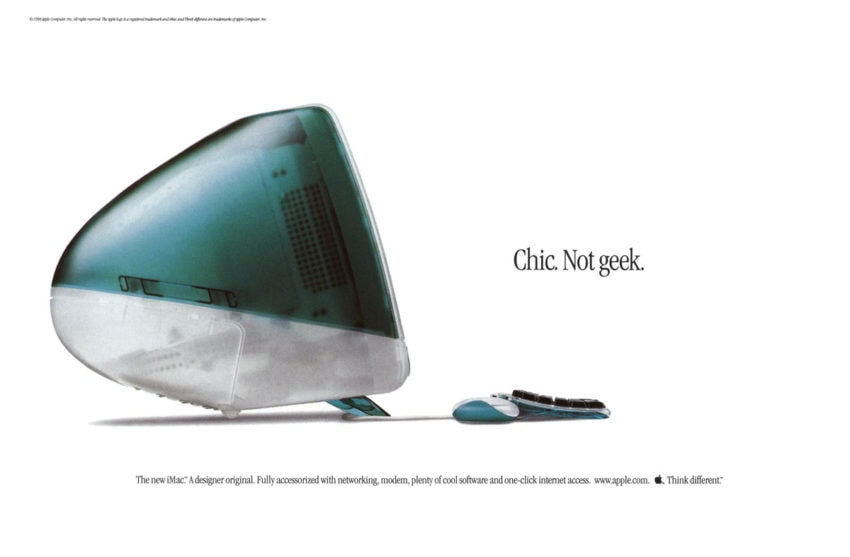Editor’s note: Apple restricts how its creative partners promote the work they create for Apple. We have omitted the name of the studio responsible for creating “Don’t Blink” at the studio’s request.
“Don’t Blink” is a breathless, high-stepping dance between word and image set to a percussion-heavy soundtrack befitting a trailer for a summer blockbuster.
Intended to recap the highlights of Apple’s September 7th press event unveiling the iPhone 7, iPhone 7 Plus and Apple Watch Series 2, the piece sheds Apple’s usual cooler-than-thou aloofness for a visual language intent on communicating one thing above all else: swagger.
Here are some of the techniques that contribute to the project’s emotional impact.
1. Animating at the speed of perception
Apple’s marketing style has long been “less is more,” a mantra that applies equally to copywriting and image-making.

Vintage iMac ad (circa 1999)
The on-screen text of “Don’t Blink” is comprised almost entirely of one- and two-syllable words, a crucial constraint for sustaining the break-neck reading pace throughout the film. Most words appear on screen for only five to seven frames. With a 29.97 framerate, that’s roughly two tenths of second per word, give or take a few hundredths of a second.
The average adult English reader consumes around 300 words per minute — or five words a second. Again assuming a 29.97 framerate, that’s roughly one word every two tenths of a second, right in line with the animation’s pace.
So even though the words appear to be popping onto the screen at the edge of comprehension, they are in comfortably in line with most people’s normal reading speed. It’s the one-at-a-time animation that conveys a sense of urgency and excitement. Simple but effective.
2. Animating the signified
Part of the appeal of typographic animations is their ability to collapse the dichotomy of signifier and signified.
In this sequence, “the design has been” is visually re-engineered into the word “re-engineered”
In plain English: You can animate the meaning of the word or phrase using the word or phrase itself. The result is a witty underscoring of select messages that functions like a mini-puzzle, spicing up otherwise predictable patterns of verbal presentation and keeping the viewer engaged.
3. Employing time as a character
If “Don’t Blink” maxed out its speedometer and simply stayed full throttle for all 107 seconds, we’d get bored, no matter how much clever imagery is packed on the timeline.
Thankfully, time itself becomes a supporting character in the project, even supplying an erudite punchline here and there. To illustrate the point, let’s look at two sequences.
The first sequence uses slick sleight of hand to transform the word “to” into a water balloon as time melts into slow motion. After a moment of anticipation, the temporal curve is flattened out, dipping us into a delightfully surreal moment of metamorphosis as the balloon’s latex magically gives way to water.
The second sequence comes much later in the piece, after a crescendo of sound and imagery has built up our expectations to near orgasmic heights.
Expecting an explosive resolution, we’re instead dumped into an elegant product lockup of AirPods accompanied by a door bell chime. The sudden stop in this minimal whitespace is so unexpected, it’s refreshingly — dare I say it? — funny.
4. Breaking the plane
Although there are ample CG product shots throughout “Don’t Blink,” nearly all of the action occurs in 2D space on an XY plane, like a cocaine-addled Keynote presentation with all the animations set to stun.
But there’s one moment that z-space drops in to say hello, again with humorous effect.
This gag didn’t come cheap. But as a grin-inducing way to interrupt a dizzying litany of technical specs, it pays off. Just when we might drift off like some hungover college student, boom! — we’re back in.
Doing it better than everyone else
There is nothing earth-shatteringly new or ground-breaking in “Don’t Blink.” The animation and editing techniques are decades old, and you’ll find dozens of other similar works online.
But the level of craftsmanship is superb and rare. It’s a singular study in balance: details versus storytelling, cleverness versus clarity, tension versus release.
In less refined examples of typographic animation, you often see unrestrained over-animation, baroque attempts to jam cleverness into every nook and cranny with no concern for the gestalt. Or worse: animation curves so divinely smooth that the type appears to slide around senselessly like jelly beans on ice, regardless of the meaning conveyed by the words themselves.
“Don’t Blink” shows what maturity and mastery look like in the realm of motion design. Type, image and sound are inextricably linked in a powerful troika that feels effortlessly confident, despite the hard work behind it.






